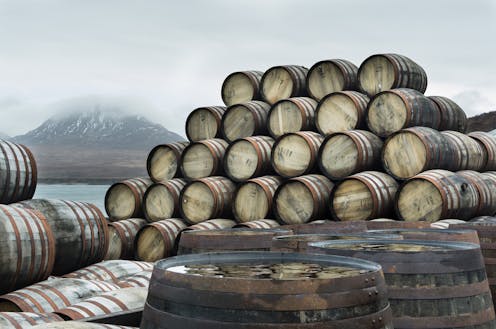How canny marketing and strong supply links gave the world a taste for Scotch whisky
- Written by Niall G MacKenzie, Professor of Entrepreneurship and Business History, University of Glasgow

Scotch whisky exports grew from £4.51 billion in 2021 to more than £6 billion[1] in 2022, while separate government figures showed a 25% sales increase last year – the biggest for any UK manufactured product except aircraft parts. Such impressive growth shows how the industry has cultivated its image, appeal and supply networks over 200 years, withstanding pandemics, trade wars and even world wars in the process.
The question of why Scotch whisky has managed to keep its global popularity over a long time period is one I’ve been researching for several years[2]. Like a good Scotch, the answer is complex and requires time to understand.
Scotch whisky producers have long looked overseas to sell their product. The UK domestic market is not and never has been big enough to meet their aspirations for growth. Some of the earliest records of Scotch being exported date to 1839 with adverts for Ardbeg Scotch from Islay[3] and others appearing in New York publications around this time.
However, it was not until later in the 19th century that the Scotch whisky industry really began to focus on going global. In the mid 1800s, the government relaxed regulations regarding blending. Previously producers were not allowed to mix or blend their individual whiskies, which were often raw and inconsistent. After the rules changed, the industry could produce a consistent and wide variety of flavours to suit different palates, giving whisky the opportunity to appeal more broadly.
Combined with already established global trade routes out of the UK, Scotch whisky blenders such as Dewar’s, Buchanan’s and Johnnie Walker were able to grow their businesses domestically and overseas.
A global taste for whisky
Today, blended Scotch whisky makes up the majority (59%)[4] of the industry’s exports by value. Blended Scotch also achieved the biggest increase in exports in the last year. It grew by 43%, fuelling the overall Scotch export value increase of 25%.
While India and China have emerged in recent years as key destinations, the early export markets established by Scotch producers such as the US, France, South America, and Asian countries including Singapore and Taiwan, are still the principal destinations for Scotch.
The industry has been subject to close attention from the Westminster government in the form of regulation and taxation for the past 200 years, starting with the Excise Act of 1823[5]. This has encouraged the industry’s overseas focus. Tariffs and outright bans such as US prohibition from 1920-1933 did little to dampen thirst for the spirit. In the case of prohibition, the industry used all manner of means to get Scotch into the US including rum runners in the Caribbean and mobster ties through Canada – most recently depicted in the TV show Peaky Blinders.
And, since the early 20th century, the UK government has recognised and pushed the export value of Scotch as a benefit to the economy. Winston Churchill a well-known Scotch drinker[6], recognised its dollar-earning value during the second world war in a 1945 government memo[7] stating:
On no account reduce the barley for whisky. This takes years to mature and is an invaluable export … Having regard to all our other difficulties about export, it would be most improvident not to preserve this characteristic British element of ascendancy.
But the focus on exports damaged the domestic trade. After US prohibition and the second world war, global Scotch whisky exports grew as a proportion from 50% of total UK production in 1939 to 75% by 1954[8]. The industry has since faced various challenges in international markets, but has still continued to grow.
Rising to the challenge
Scotch exports have been slower in recent years[10] due to the combined effects of free movement (affecting the important duty-free market for Scotch) and trade restrictions arising from the global pandemic, Brexit and the introduction of high tariffs in key markets[11] such as the US and India. But whisky producers have clearly learned lessons from a long history of responding to global challenges.
The industry quickly adapted by focusing on quality and luxury and pushing new products. The emergence of single malts over the past 30 years[12] as a distinct product in export markets is a good example of this. Prior to the early 1990s, single malt was a relatively niche product without significant reach into markets either at home or abroad[13]. Then, a global collapse in demand for blended Scotch led to an overstocking of single malt “fillings” – the ingredients for blended Scotch.
The industry used marketing, branding and distribution strategies to turn this overstock into a luxury product by building the perception of scarcity, and value in age and provenance. Single malts have since grown to comprise around a quarter of the value of Scotch exports.
Ultimately, the Scotch whisky industry’s recent success in export growth did not happen overnight. It has taken a long time to develop and mature. Much like a good Scotch whisky.
References
- ^ to more than £6 billion (www.scotch-whisky.org.uk)
- ^ researching for several years (www.gla.ac.uk)
- ^ adverts for Ardbeg Scotch from Islay (www.ardbegproject.com)
- ^ the majority (59%) (www.scotch-whisky.org.uk)
- ^ Excise Act of 1823 (www.scotch-whisky.org.uk)
- ^ a well-known Scotch drinker (economictimes.indiatimes.com)
- ^ a 1945 government memo (scotchwhisky.com)
- ^ from 50% of total UK production in 1939 to 75% by 1954 (www.tandfonline.com)
- ^ barmalini/Shutterstock (www.shutterstock.com)
- ^ slower in recent years (www.bbc.co.uk)
- ^ high tariffs in key markets (www.thedrinksbusiness.com)
- ^ over the past 30 years (www.tandfonline.com)
- ^ either at home or abroad (www.tandfonline.com)







